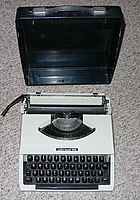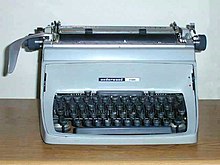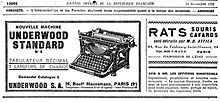 Exterior of the Underwood Typewriter Company with vehicle outside c. 1905 Exterior of the Underwood Typewriter Company with vehicle outside c. 1905 | |
| Company type | Private company |
|---|---|
| Industry | Business machines |
| Founded | 1895; 130 years ago (1895) |
| Founder | John T. Underwood |
| Defunct | 1963; 62 years ago (1963) |
| Fate | Acquired by Olivetti (1959) |
| Headquarters | Manhattan, New York, U.S. |
| Key people | Franz X. Wagner (inventor) |
| Products | Typewriters |
| Parent | Olivetti |
The Underwood Typewriter Company was an American manufacturer of typewriters headquartered in New York City, with manufacturing facilities in Hartford, Connecticut. Underwood produced what is considered the first widely successful, modern typewriter. By 1939, Underwood had produced five million machines.
History
| This section needs additional citations for verification. Please help improve this article by adding citations to reliable sources in this section. Unsourced material may be challenged and removed. (January 2021) (Learn how and when to remove this message) |

In 1874, the Underwood family made typewriter ribbon and carbon paper, and was among a number of firms that produced these goods for Remington. When Remington decided to start producing ribbons themselves, the Underwoods opted to manufacture typewriters.

The original Underwood typewriter was invented by German-American Franz Xaver Wagner, who showed it to entrepreneur John Thomas Underwood. Underwood supported Wagner and bought the company, recognizing the importance of the machine.
The Underwood Number 5 launched in 1900 has been described as "the first truly modern typewriter." Two million of these typewriters had been sold by the early 1920s, and their sales “were equal in quantity to all of the other firms in the typewriter industry combined.” When the company was in its heyday as the world's largest typewriter manufacturer, its factory in Hartford, Connecticut was turning out typewriters at the rate of one per minute and, along with Royal Typewriter Company, made Hartford the “Typewriter Capitol of the World”.
Philip Dakin Wagoner was appointed president of the Elliott-Fisher Company after World War I (1914-1918). Elliott-Fisher became the parent company of the Underwood Typewriter Company and the Sundstrand Adding Machine Co. In 1927 Wagoner reorganized the company into Underwood-Elliott-Fisher, which later became the Underwood Corporation. The reorganization was completed in December 1927. John Thomas Underwood was elected chairman and Wagoner president of Underwood Elliott-Fisher.
In the years before World War II, Underwood built the world's largest typewriter in an attempt to promote itself. The typewriter was on display at Garden Pier in Atlantic City, New Jersey, for several years and attracted large crowds. Often, Underwood would have a young woman sitting on each of the large keys. The enormous typewriter was scrapped for metal when the war started.
During World War II, Underwood produced M1 carbines. Approximately 540,000 M1 carbines were produced from late 1942 to May 1944. Underwood also produced M1 carbine barrels for the U.S. government. Under the Free Issue Barrel Program, barrels were sent to other prime manufacturers who did not possess the machines to make barrels.
In 1945 Wagoner was elected chairman of the board of Underwood, and Leon C. Stowell was elected president. Wagoner remained chief executive. Olivetti bought a controlling interest in Underwood in 1959, and completed the merger in October 1963, becoming known in the U.S. as Olivetti-Underwood with headquarters in New York City, and entering the electromechanical calculator business.
By the 1970s and 1980s, the typewriter market had matured under the market dominance of large companies from Britain, Europe and the United States — but before the advent of daisy wheel and electronic machines — Underwood and the other major manufacturers faced strong competition from typewriters from Asia, including Brother Industries and Silver Seiko Ltd. of Japan.
The Underwood brand appears in 2021 on some cash registers produced by Olivetti.
Notable users
Some writers who had endorsed with Underwood typewriters such as William Faulkner, F. Scott Fitzgerald, Ernest Hemingway and Robert E. Howard.
In popular media
The Underwood brand of typewriters is mentioned and seen in the TV Series House of Cards. In episode 25, main character and Vice President of the United States Frank Underwood uses an Underwood typewriter to write a letter to President Garrett Walker. In this letter, he implies his father as having been an heir to the Underwood typewriter fortune. Episode 27 reveals Frank's father to have been named Calvin, and no Calvin Underwood ever held stake or sway over the typewriter company.
In the film The Day of the Jackal, an Underwood typewriter is used by a French police officer while being dictated to by his superior officer. In the scene the machine is filmed looking at the rear panel where the name Underwood is visible.
Gallery
-
 William Faulkner's Underwood Universal Portable in his office at Rowan Oak, which is now maintained by the University of Mississippi in Oxford as a museum.
William Faulkner's Underwood Universal Portable in his office at Rowan Oak, which is now maintained by the University of Mississippi in Oxford as a museum.
-
 A student's portable underwood 255 manufactured circa 1977 in Japan
A student's portable underwood 255 manufactured circa 1977 in Japan
-
 The Underwood Touch-Master 5 was among the last desktop models produced at the Underwood factory in the early 60s
The Underwood Touch-Master 5 was among the last desktop models produced at the Underwood factory in the early 60s
-
 Underwood No. 5, in the collection of The Children's Museum of Indianapolis
Underwood No. 5, in the collection of The Children's Museum of Indianapolis
-
 During World War II Underwood produced M1 Carbines for the War Department
During World War II Underwood produced M1 Carbines for the War Department
-
An Underwood typewriter with Armenian letters.
-
 "Underwood standard n° 6" advertisement in France
"Underwood standard n° 6" advertisement in France
-
 Underwood typewriter advertisement in Russia (1900)
Underwood typewriter advertisement in Russia (1900)
-
 Underwood Portable typewriter at the Museum Europäischer Kulturen
Underwood Portable typewriter at the Museum Europäischer Kulturen
-
 Ernest Hemingway's portable Underwood typewriter
Ernest Hemingway's portable Underwood typewriter
-
 Underwood 450, Italian version, detail
Underwood 450, Italian version, detail
References
- "John Wolff's Web Museum – Olivetti Mechanical Calculators".
- Depauw, Karen (November 10, 2014). "Typing History". WNPR.
- "Underwood No. 5". The Classic Typewriter Page. Retrieved 26 April 2022.
- "Perfecting the Writing Machine: Blind and Visible Writing Typewriters". British Library. Retrieved 26 April 2022.
- George Nichols Engler (1969). The Typewriter Industry: The Impact of a Significant Technological Revolution (PhD dissertation). University of California at Los Angeles. p. 30.
- "West Mountain Historic District". National Park Service. 27 January 1984. p. 13. Retrieved 2013-10-18.
- "Time, monday, Dec. 05, 1927". Time. 5 December 1927. Archived from the original on November 13, 2009.
- Alford, Leon Pratt (1928). Manufacturing Industries. Ahrens Publishing Company. p. 159. Retrieved 2013-10-18.
- McLain, Bill. What Makes Flamingo's Pink. New York, New York, 2001.
- "U.S. Underwood Elliot Fisher M1 Carbine". NRA Museum. Retrieved 26 April 2022.
- "The U.S. Caliber .30 Carbines - Barrel Manufacturers". www.uscarbinecal30.com. Retrieved 26 April 2022.
- *The Office. Office Publications. 1945. p. 88.
- "Registratori di cassa Underwood | Olivetti SPA". www.olivetti.com. Retrieved 2021-03-22.
- "Writers and their Typewriters". The Classic Typewriter Page. Retrieved 26 April 2022.
External links
[REDACTED] Media related to Underwood Typewriter Company at Wikimedia Commons
| Olivetti | |||||||||
|---|---|---|---|---|---|---|---|---|---|
| Key people |
| [REDACTED] | |||||||
| Computers |
| ||||||||
| Typewriters |
| ||||||||
| Locations | |||||||||
| Acquisitions |
| ||||||||
| [REDACTED] Commons category | |||||||||
| Typewriters | |
|---|---|
| Manufacturers | |
| Models | |
| Prominent figures | |
| Components | |
| Related equipment | |
| Other scripts | |
| Cultural and health aspects | |
- 1895 establishments in New York City
- American companies established in 1895
- Manufacturing companies established in 1895
- 1959 mergers and acquisitions
- 1963 disestablishments in New York (state)
- American companies disestablished in 1963
- Manufacturing companies disestablished in 1963
- Typewriters
- Olivetti S.p.A.
- Defunct manufacturing companies based in New York City